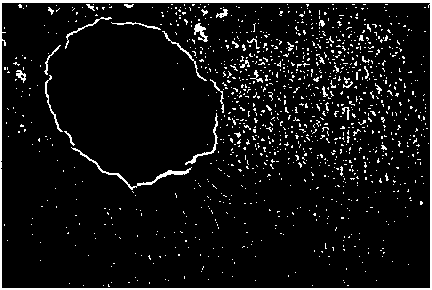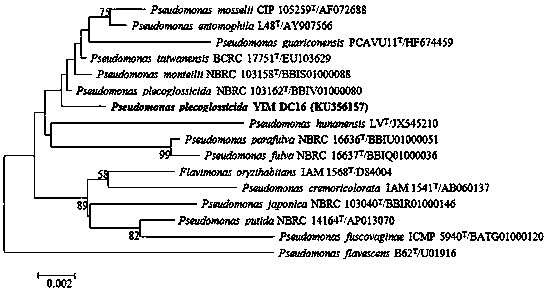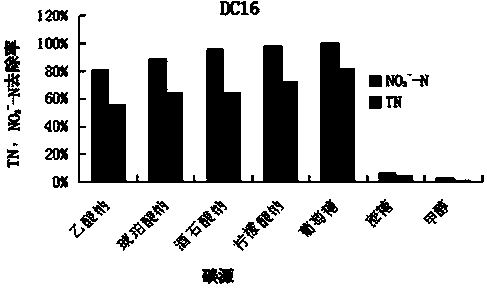An aerobic denitrifying bacteria and its application
An aerobic denitrification and bacteria technology, applied in the field of environmental microorganisms, can solve the problems of high operating cost, complicated operation and large energy consumption.
- Summary
- Abstract
- Description
- Claims
- Application Information
AI Technical Summary
Problems solved by technology
Method used
Image
Examples
Embodiment 1
[0023] Embodiment 1: Isolation of aerobic denitrification bacterial strain YIM DC16
[0024] (1) The medium and components used are as follows:
[0025] Enrichment medium (g / L): KNO 3 2 g, K 2 HPO 4 1 g, KH 2 PO 4 1 g, MgSO 4 ·7H 2 O 0.2 g, sodium citrate 5 g, trace salt solution 2 mL; distilled water 1000 mL, adjust pH 7.0-7.2 with 1N NaOH;
[0026] Among them, trace salt solution (g / L): EDTA 50 g, ZnSO 4 ·7H 2 O 22 g, CaCl 2 5.54 g, MnCl 2 4H 2 O5.06 g, FeSO 4 ·7H 2 O 4.99 g, (NH 4 ) 6 Mo 7 o 24 4H 2 O 1.10 g, CuSO 4 ·5H 2 O 1.57 g, CoCl 2 ·6H 2 O 1.61 g.
[0027] BTB medium (g / L): bromothymol blue (BTB) selective medium, agar 15 g, KNO 3 1g, KH 2 PO 4 1 g, FeCl 2 ·6H 2 O 0.5 g, CaCl 2 ·7H 2 O 0.2 g, MgSO 4 ·7H 2 O 1 g, sodium succinate 8.5 g, BTB (1% dissolved in alcohol) 1 mL; distilled water 1000 mL, adjust pH 7.0-7.2 with 1N NaOH.
[0028] LB medium (g / L): 10 g peptone, 5 g NaCl, 5 g yeast extract, 15 g agar.
[0029] Denitrificati...
Embodiment 2
[0036] Embodiment 2: Molecular biology identification of bacterial strain YIM DC16 bacterial strain
[0037] (1) Colony morphological characteristics: The colony morphological characteristics of YIM DC16 cultured on LB medium for 24 h were round, smooth and milky white. Gram-stain negative, the cells are rod-shaped with flagella (see figure 1 ).
[0038] (2) Use Takara's Lysis Buffer to extract the genomic DNA of strain YIM DC16, use it as a template, PCR amplify its 16S rRNA gene, separate the PCR product by 1% agarose gel electrophoresis, and pass through the gel recovery kit Perform DNA purification. The 16S rRNA gene fragment of strain YIM DC16 was transformed into E. coli In DH5α, positive clones were selected and sent to Shanghai Sangong for sequence determination. The sequence is shown in the sequence table as SEQ ID NO: 1; the sequencing results were compared and analyzed with the 16S rRNA gene sequences in the GenBank and Eztaxon databases to obtain the identiti...
Embodiment 3
[0042] Example 3: Effects of different environmental factors on denitrification performance of aerobic denitrification strain YIM DC16
[0043] Basal medium: KNO 3 0.6 g, KH 2 PO 4 1 g, K 2 HPO 4 1 g, MgSO 4 ·7H 2 O 0.2 g, deionized water 1000 mL.
[0044] The effect of different carbon sources on the denitrification efficiency of strains: glucose, sucrose, sodium acetate, sodium succinate, sodium citrate, sodium tartrate and methanol were used as the only carbon source to test the denitrification effect, under the conditions of 30 ℃ and 160 rpm Cultivate for 48 h. The results showed that aerobic denitrifying bacteria did not have good denitrification effects in sucrose and methanol media, but had better denitrification effects in glucose, sodium succinate, sodium citrate, sodium acetate and sodium tartrate media, especially In glucose, sodium citrate and sodium tartrate medium, the removal rate of nitrate was above 95%, and in the medium with glucose as carbon sour...
PUM
 Login to View More
Login to View More Abstract
Description
Claims
Application Information
 Login to View More
Login to View More - R&D
- Intellectual Property
- Life Sciences
- Materials
- Tech Scout
- Unparalleled Data Quality
- Higher Quality Content
- 60% Fewer Hallucinations
Browse by: Latest US Patents, China's latest patents, Technical Efficacy Thesaurus, Application Domain, Technology Topic, Popular Technical Reports.
© 2025 PatSnap. All rights reserved.Legal|Privacy policy|Modern Slavery Act Transparency Statement|Sitemap|About US| Contact US: help@patsnap.com



